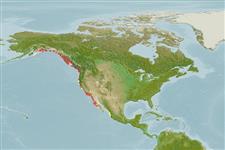Teleostei (teleosts) >
Scombriformes (Mackerels) >
Scombridae (Mackerels, tunas, bonitos) > Scombrinae
Etymology: Sarda: Latin and Greek, sarda = sardine; name related to the island of Sardinia (Ref. 45335).
More on author: Girard.
Issue
This species was usually referred to as a subspecies of Sarda chiliensis Cuvier, 1832. Until further work, it is elevated here at species rank following Clemens & Wilby (1961: Ref. 4925).
Environment: milieu / climate zone / depth range / distribution range
Ecology
Marine; pelagic-neritic; oceanodromous (Ref. 51243). Subtropical; 61°N - 20°N
Northeast Pacific: Off the coast of Alaska (60°16'N, 145°32'W) to Cabo San Lucas at the tip of Baja California (22°20'N, 112°27'W) and Revillagigedo Islands.
Size / Weight / Age
Maturity: Lm ? range ? - ? cm
Max length : 102 cm FL male/unsexed; (Ref. 168); max. published weight: 11.3 kg (Ref. 168)
An inshore species that forms schools by size (Ref. 168). Feeds on a variety of small schooling fishes, squids and shrimps (Ref. 168). An important food fish (Ref. 4925).
Life cycle and mating behavior
Maturity | Reproduction | Spawning | Eggs | Fecundity | Larvae
McAllister, D.E., 1990. A list of the fishes of Canada. Syllogeus No. 64. Nat. Mus. Nat. Sci., Ottawa, Canada. 310 p. (Ref. 11980)
IUCN Red List Status (Ref. 130435: Version 2024-1)
Threat to humans
Harmless
Human uses
Fisheries: commercial; gamefish: yes
Tools
Special reports
Download XML
Internet sources
Estimates based on models
Preferred temperature (Ref.
123201): 8.6 - 17.8, mean 10.3 °C (based on 68 cells).
Phylogenetic diversity index (Ref.
82804): PD
50 = 0.5312 [Uniqueness, from 0.5 = low to 2.0 = high].
Bayesian length-weight: a=0.00955 (0.00460 - 0.01984), b=3.06 (2.89 - 3.23), in cm total length, based on LWR estimates for this (Sub)family-body shape (Ref.
93245).
Trophic level (Ref.
69278): 4.2 ±0.60 se; based on food items.
Resilience (Ref.
120179): Medium, minimum population doubling time 1.4 - 4.4 years (K=0.6).
Fishing Vulnerability (Ref.
59153): High to very high vulnerability (68 of 100).
Climate Vulnerability (Ref.
125649): High to very high vulnerability (75 of 100).
Nutrients (Ref.
124155): Calcium = 37.9 [21.2, 63.3] mg/100g; Iron = 2.61 [1.51, 4.59] mg/100g; Protein = 20.7 [19.5, 21.8] %; Omega3 = 0.353 [0.166, 0.740] g/100g; Selenium = 31.8 [17.6, 55.3] μg/100g; VitaminA = 13.9 [5.5, 37.7] μg/100g; Zinc = 0.462 [0.351, 0.690] mg/100g (wet weight);
